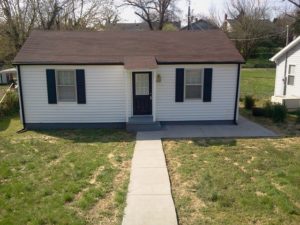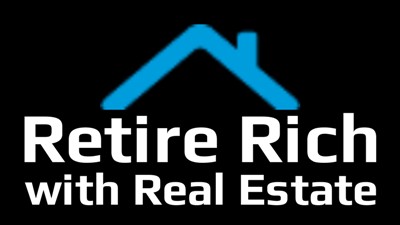So how do you actually retire by replacing your earned income with passive income from Real Estate? Actually, it's very simple math. First, you must determine how much money you need to replace your current income.
The average salary in the United States right now is somewhere between $55,000 and $60,000 a year. If we use that as an example you would need $5,000 a month to replace a $60,000 a year salary. Here is how this can be achieved through rental real estate. It will not happen overnight, but over several years it could be easily accomplished. How fast you reach this goal will depend on your drive and determination to succeed. If you continue to invest money made from the income of your current job and reinvest your profits you could greatly speed up this process.
Let’s run the numbers… if you make $60,000 a year and you're trying to replace that income, you will have to figure out how many houses would it take to generate $60,000.
Personally, I have used cash to buy most of my houses, that's obviously the best scenario from an income standpoint because you have no mortgage payment. It may not be possible for you to pay cash, but if you can do this, it allows you to have more cash flow. If you finance your properties you will have to adjust your numbers to include the mortgage payments.
Here in Tennessee, where I live, I have found the most profitable houses to be older cottage-style homes. These houses are small and boxy, usually consisting of only 4 main rooms (a kitchen, living room, and 2 bedrooms) plus a single bath. They were built by the thousands after World War  II as homes for returning GI’s. I like to purchase these as rental homes because they are abundant, cheap to buy, cheap to repair and cheap to maintain. Locally, these houses can be purchased for under $30,000 and make great rental properties typically bringing in around $700 a month. This is the type of property is what we’ll use in this example and we’ll also use the following assumptions. We will purchase with all cash. The taxes, insurance, maintenance, repairs, and a small allowance for vacancies, will on average usually run around $200 a month. Since we are assuming you don't have a mortgage on any of these properties and you are self-managing them, your profit should be around $500 a month per house. If each house nets $500 a month you would need 10 houses to replace a $5,000 a month income.
II as homes for returning GI’s. I like to purchase these as rental homes because they are abundant, cheap to buy, cheap to repair and cheap to maintain. Locally, these houses can be purchased for under $30,000 and make great rental properties typically bringing in around $700 a month. This is the type of property is what we’ll use in this example and we’ll also use the following assumptions. We will purchase with all cash. The taxes, insurance, maintenance, repairs, and a small allowance for vacancies, will on average usually run around $200 a month. Since we are assuming you don't have a mortgage on any of these properties and you are self-managing them, your profit should be around $500 a month per house. If each house nets $500 a month you would need 10 houses to replace a $5,000 a month income.
If you are financing the houses, the mortgage payment amount would have to be subtracted from the $500 profit. While we are on the subject of financing, you may have to get creative when financing a low priced (under $50,000) property. It can be difficult to find conventional financing for properties under $50,000 in price, especially if they are in need of repair. Most banks have minimum mortgage lending amounts and the house must be in a livable condition. If you can not find a conventional lender, don’t be discouraged, you still may be able to use a private lender, owner financing, hard money, or partners. You might even consider borrowing from friends or family.
The Snowball Approach
Let’s take the example above a step farther. The average cost of the houses I’m buying right now is probably around $30,000 to purchase including any repairs needed to get them ready to rent. Let’s assume you can do the same. Using the same numbers as before, rent for the property is $700 a month, subtract $200 a month for expenses, leaving you with a $500 per month profit. You should be able to grow that profit using what I call the snowball approach. So instead of spending the $500 profit, you save it toward the purchase of your next property. Assuming you can buy the next property for the same $30,000 price. It should take about 60 months or 5 years to purchase your second property. This assumes you add no money to the pot. If you wanted to speed things up you could put in extra money from other income sources (so don’t quit your day job!). If you rented the second house for $700 and had the same $500 profit. You now have $1000 per month to put towards saving for your next house. Now because you have doubled your income you have cut the time needed to save $30,000 in half. Now you will have that amount in only 30 months or 2.5 years. If you continue with this method your time between houses gets shorter and shorter with each purchase, as your income gets larger and larger, like a snowball rolling downhill, hence the name snowball approach.
Snowball Approach |
||||||
|
Property |
Monthly |
Months |
Total Time |
|||
|
# |
Price |
Rent |
Expenses |
Total Profit |
||
|
1 |
$30,000 |
$700 |
$200 |
$500 |
60 |
5 |
|
2 |
$30,000 |
$700 |
$200 |
$1000 |
30 |
7.5 |
|
3 |
$30,000 |
$700 |
$200 |
$1500 |
20 |
9.2 |
|
4 |
$30,000 |
$700 |
$200 |
$2000 |
15 |
10.4 |
|
5 |
$30,000 |
$700 |
$200 |
$2500 |
12 |
11.4 |
|
6 |
$30,000 |
$700 |
$200 |
$3000 |
10 |
12.3 |
|
7 |
$30,000 |
$700 |
$200 |
$3500 |
9 |
13 |
|
8 |
$30,000 |
$700 |
$200 |
$4000 |
8 |
13.7 |
|
9 |
$30,000 |
$700 |
$200 |
$4500 |
7 |
14.3 |
|
10 |
$30,000 |
$700 |
$200 |
$5000 |
6 |
14.8 |
This chart shows how the Snowball Approach works. As you can see in this example, it would take roughly 15 years to replace a $5,000 a month income using this method with no adjustments. I know that might seem like a long time but I can assure you with a little tweak here or there you can speed this system up. We have bought over 16 houses in 7 years using this method. We did pay cash out of pocket for the first two houses and their initial repairs. On the purchase of the 12th house, we did an owner finance deal, the rest of the houses were paid for with cash from profits. Also along the way, we sold one house. Selling that house at a nice profit increased our cash reserve and allowed us to negotiate a package deal to buy three more houses from another investor. The owner finance deal enabled us to purchase a house out of our niche and price range (it was a 2000 Sqft. 3BR 2.5 BA), and helped us conserve cash while increasing cash flow. These two things greatly increased our income and sped up the process. Another way we sped up the process was to concentrate on buying distressed properties for less than the $30,000. Then we used the profits from the previous houses to pay for the repairs to these houses before we rented them. Here’s an example. One house we bought, we only paid $18,000 for it and spent about $8,000 on repairs, bringing us up to $26,000 invested. It really could have used a new roof when we remodeled it. The shingles had some age on them, but the roof wasn’t leaking, so we decided to go ahead rent it first and wait to replace the roof shingles. About 3 years later the tenant started seeing leaks in the roof. So, we replaced the roof at that time. That $4000 roof brought our total investment in the property up to $30,000 but it was after we had been collecting rent on the property 3 years at $800 per month (that’s $28,800 in cash flow). We had more than recouped our initial $26,000 investment by the time we did the repairs. We also were able to get a higher rent because the house was a 3 bedroom. By prioritizing repairs and delaying the unnecessary repairs, you may be able to speed up the Snowball. It would not be unrealistic to build a portfolio of 10 houses in as little 3 to 5 years. Maybe faster if you really put your mind to it.
How do you get started if you have no cash? Financing is a possibility, but it may be hard to get, will greatly slow the process and will create more work for you. In most cases, you will have to put some money down on the property, but let’s assume you can get a no-money-down deal and you're financing $30,000 just to make the math easy. Say you borrow $30,000 at an interest rate of 6%. Interest is always going to be a little higher on a non-owner occupied or investment property and normally the banks will only lend for 20 years instead of 30 years. $30,000 at 6% for 20 years is about $215 a month. Many banks will not write a loan with such a low payment, if they will even lend you such a low amount, so you may have to settle for a 15 year or even a 10-year note. Even at 10 years, you're only looking at $330 a month. Using the same figures from before, $700 a month rental income less $200 for taxes insurance and repairs. That leaves $500 less the mortgage of $330 resulting in a net profit of $170 a month. If you only make $170 a month and you have to replace an income of $5000 a month It's going to take you 29 houses. That’s almost 3 times as many houses! Now you can see what I mean by slowing the process down to reach your goal. I can also assure you it will take a lot more work to manage 29 houses than 10.
Please note: These numbers are NOT real numbers and are only for illustration purposes. The numbers used are overly simplified to help you understand these concepts and strategies

